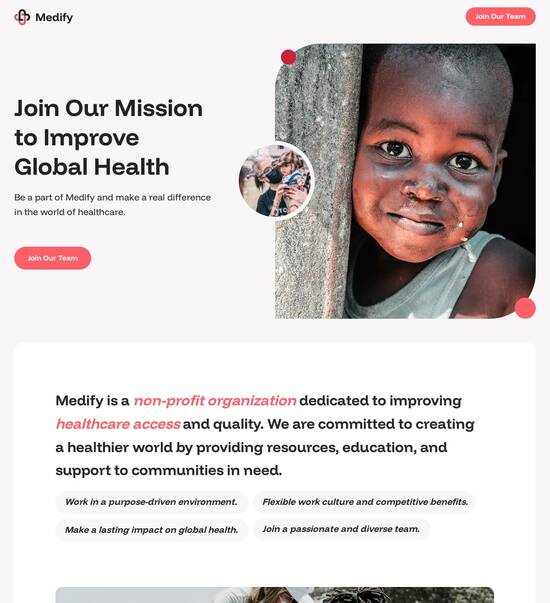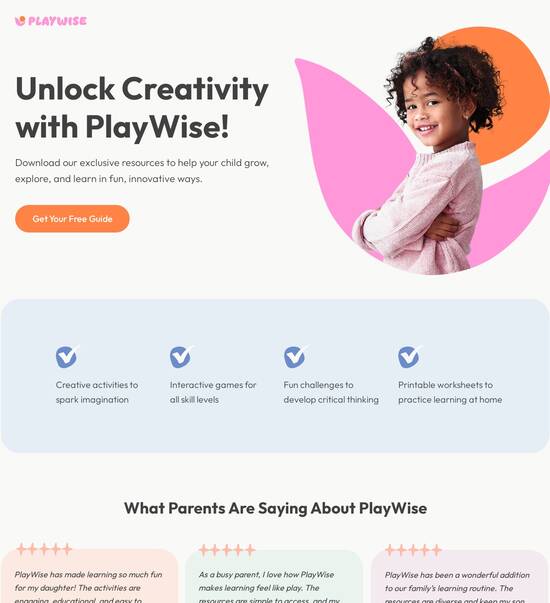
HTML page templates optimized for Safari
Explore Similar TemplatesAbout template
Try out HTML page templates optimized for Safari and reach your clients without breaking a sweat. Take a step forward with an intuitive and compliant solution.
Recommended templates

Easy to build without coding
With the intuitive drag-and-drop builder, anyone on your team can create high-converting pages without any knowledge of code or design. Make enhancements to your landing page with custom widgets using Javascript, HTML/CSS, or third-party scripts.

Multiple layouts for any industry and goal
Select from 500+ landing page layouts built to boost conversions across industry-specific scenarios. Customize them by adjusting fonts, adding images, and generating on-brand content with the AI assistant. Quickly scale with Instablocks® and Global Blocks that you can save, reuse, and update globally.

Loads fast and looks polished on any device
Every template is responsive, which means they present professionally on any device and load blazingly fast with our Thor Render Engine. You can also power them up with Google AMP technology to deliver an unparalleled mobile experience and drive higher conversions.

Robust analytics & experimentation
Get real-time updates and reporting across all your devices, showing the number of visitors, conversions, cost-per-visitor, and cost-per-lead. Launch AI-powered experiments, run A/B tests, and use heatmaps to analyze user behavior, then optimize your landing page to maximize conversions.







Easy to build without coding
With the intuitive drag-and-drop builder, anyone on your team can create high-converting pages without any knowledge of code or design. Make enhancements to your landing page with custom widgets using Javascript, HTML/CSS, or third-party scripts.
Multiple layouts for any industry and goal
Select from 500+ landing page layouts built to boost conversions across industry-specific scenarios. Customize them by adjusting fonts, adding images, and generating on-brand content with the AI assistant. Quickly scale with Instablocks® and Global Blocks that you can save, reuse, and update globally.
Loads fast and looks polished on any device
Every template is responsive, which means they present professionally on any device and load blazingly fast with our Thor Render Engine.
Robust analytics & experimentation
Get real-time updates and reporting across all your devices, showing the number of visitors, conversions, cost-per-visitor, and cost-per-lead. Launch AI-powered experiments, run A/B tests, and use heatmaps to analyze user behavior, then optimize your landing page to maximize conversions.
All the features you need to build lead-generating landing pages
Explore more featuresLearn how to build top-performing landing pages for any goal
FAQs
Leading the way in building high-performing landing pages





A step-by-step guide to leveraging Instapage for superior landing page optimization
In the competitive landscape of digital marketing, optimizing landing pages is crucial for maximizing ROI. Instapage offers an array of tools designed to help marketers, particularly within sectors like financial services and technology, create high-converting landing pages effortlessly.
Understanding the essentials of landing page creation
Creating an effective landing page begins with understanding your audience and their needs. Instapage provides over 100 customizable templates and access to lead generation elements that allow marketers to quickly build pages without needing technical skills. Utilizing these resources, you can significantly enhance your conversion rates.
- High-converting templates: Use professional templates proven to yield better results, saving time on design.
- Lead generation elements: Include forms and calls-to-action that seamlessly guide visitors to take action.
- Intuitive design tools: Leverage user-friendly builders to customize layouts without coding.
Step 1: Optimizing your landing pages with A/B testing
A/B testing is integral to improving your landing page performance. Instapage's built-in experimentation features enable you to test different layouts, headlines, and content to discover what works best for your audience.
Step 2: Personalization for better engagement
Incorporating personalization elements enhances the user experience, creating a sense of relevance for each visitor.
- Dynamic text replacement: Tailor the content based on the visitor's search intent.
- AdMaps: Align specific ads with designated landing pages for a consistent message.
- Audience-level tracking: Utilize data tools to measure engagement tailored to specific demographics.
Step 3: Streamlining collaboration for quicker execution
Effective collaboration can drastically reduce the time it takes to publish a landing page. Instapage allows for real-time feedback and edits, helping teams work smoothly without interruptions.
- Instant feedback: Facilitate discussion among team members during edits.
- Real-time edits: Collaborate with colleagues without the hassle of multiple versions.
- Secure sharing: Share pages with stakeholders and clients while maintaining control over edits.
By following these steps, marketers can not only boost their landing page performance but also ensure that every campaign maximizes its potential to convert visitors into customers.
Ready to transform your landing pages? Sign up for Instapage today and start leveraging these powerful tools to enhance your marketing strategy.
People also ask about HTML page template optimized for Safari
HTML page template optimized for Safari
Understanding the landscape of browser optimization
In the world of web development, browser optimization is crucial to ensure a seamless user experience across various platforms. Each browser has its unique rendering capabilities and limitations, making it essential for developers to design templates that cater specifically to these variants. Safari, being one of the leading browsers, particularly on macOS and iOS devices, requires special consideration in the design process.
The importance of browser compatibility cannot be overstated. Developers often aim for cross-browser functionality to reach a wider audience, but Safari's distinctive ecosystem warrants tailored optimization strategies. With a significant user base in various key demographics, neglecting Safari could result in missed opportunities for engagement, sales, and brand trust.
Overview of industry standards: HTML5, CSS3, and JavaScript frameworks that form the backbone of modern web applications.
Why Safari's optimization matters: Safeguarding user experience and maintaining brand reliability across different Apple devices.
Safari's unique features and technologies
Safari employs the WebKit rendering engine, a critical component in how it interprets HTML and CSS. This engine is designed for speed and performance, supporting a range of modern web standards. Developers must familiarize themselves with WebKit’s behavior to ensure that their HTML templates will render correctly. Unique attributes of WebKit may cause discrepancies in how pages are displayed when compared to other browsers.
Moreover, Safari places a strong emphasis on user privacy and security, transforming the way web content is served. Features such as Intelligent Tracking Prevention (ITP) can affect the availability of certain script elements and cookies. This focus on privacy means that developers need to be mindful of how their templates manage data and interact with third-party functionalities.
Diving into HTML page templates
HTML remains the foundation of modern web development, allowing developers to create structured content that is both effective and functional. The basic structure of an HTML page consists of elements such as , , and , which together dictate how content is organized and displayed within various browsers, including Safari.
Utilizing semantic HTML is especially important for accessibility, making it easier for assistive technologies to interpret the contents of a web page. Elements like , , and provide meaningful context, ensuring that all users have access to the site’s information, enhancing their experience.
Meta tags and viewport settings for responsive design: Essential for mobile users and compatibility with various screen sizes.
Utilizing HTML5 features like , , and : These elements allow for easy integration of multimedia and interactivity.
Integrating multimedia content effectively: Employing responsive images and alternative formats to optimize loading times.
Features that enhance Safari optimization
Aligning your HTML page template with Safari’s specific performance metrics is crucial. Lazy loading images and videos is one effective technique that ensures that media is only loaded when it enters the viewport, significantly reducing initial load times and improving perceived performance. This method is particularly significant for Safari on mobile devices, where loading large resources can detract from the user experience.
Another way to optimize is by incorporating CSS animations. Rather than large JavaScript libraries, leveraging CSS for animations can lead to smoother transitions and enhance interactivity without placing undue strain on the browser's processing capabilities, which is critical for maintaining the performance of apps and sites.
Lazy loading images and videos: Understand techniques that help reduce loading time.
Leveraging CSS animations for smoother UI: Achieving engaging user experiences without heavy scripts.
CSS and JavaScript compatibility
Utilizing feature queries in CSS is another method to ensure optimal styling across browsers. By checking for specific capabilities before applying styles, developers can tailor the appearance of their templates to leverage browser strengths while maintaining functionality across others, including Safari. It's necessary to adopt a fluid approach to design to ensure that content maintains its integrity across different platforms.
In addition to styling considerations, employing polyfills and fallbacks can enhance JavaScript compatibility. This strategy addresses features unsupported by certain browsers by providing alternate code or functionality, ensuring that your optimized HTML page template works well in Safari without sacrificing features.
Structure and layout considerations
With the rise of mobile browsing, mobile-first design strategies are vital in accessing Safari’s user base. Flexible grids and fluid layouts ensure that HTML templates adapt to varying screen sizes, creating a more cohesive experience. By adopting a mobile-first perspective, developers can prioritize essential features and ensure that their pages load quickly and efficiently on iOS devices.
Tailoring breakpoints specifically for iOS devices can further enhance compatibility. Understanding the diverse range of iPhone and iPad sizes allows developers to create designs that seamlessly adjust to different dimensions, ensuring content looks optimal regardless of device.
The significance of flexible grids and fluid layouts: Enhancing usability across devices.
Tailoring breakpoints for iOS devices: Accommodating various screen dimensions to guarantee proper display.
Accessibility features
Implementing ARIA roles in your HTML templates ensures improved user experience for individuals using assistive technologies. These roles provide meaningful context and enhance navigation, proving to be beneficial for everyone while bolstering overall accessibility standards.
Furthermore, ensuring color contrast and font legibility in your templates is essential. Given Safari's unique rendering, developers must be diligent in the choices they make concerning color schemes and typography to guarantee that content remains readable and visually appealing to all users.
Community insights: Feedback and collaboration
Engaging with developer communities can provide numerous benefits for optimizing HTML templates for Safari. Platforms like GitHub and Stack Overflow offer collaborative spaces where developers can share insights, solve problems, and crowdsource information that can significantly elevate the design process. Being active in such communities fosters knowledge exchange and contributes to continuous improvement.
Collective knowledge sharing across forums and online discussions promotes innovative solutions for common challenges. This dynamic environment encourages developers to think outside the box and stay updated on best practices specifically related to Safari's functionalities and user expectations.
Platforms for collaboration: Utilizing GitHub and Stack Overflow to connect with fellow developers.
Collective knowledge sharing: Engaging in forums and discussions to broaden your understanding.
Gathering user feedback for continuous improvement
User feedback is a precious resource for developers striving to create optimized HTML templates. Implementing Q&A sessions can help address common issues that arise in Safari, guiding future development and troubleshooting efforts. By welcoming user input, developers can make informed adjustments to enhance performance.
Additionally, collecting data from usability testing is essential. These analyses can refine templates, ensuring they meet the demands of the user base while functioning correctly in Safari. Incorporating real user experiences aids in evolving templates to optimize performance and engagement.
Advanced features for enhanced user experience
Personalizing content delivery can significantly improve user engagement. By using cookies and local storage, developers can track user preferences and create tailored experiences that resonate with unique audiences. This approach not only enhances user satisfaction but can also increase conversion rates by catering specifically to user interests.
Dynamic content updates using AJAX in Safari allow for seamless user interactions without the need for full-page reloads. This feature is especially important for improving site performance, allowing users to receive the information they need promptly without disrupting their browsing experience.
How to use cookies and local storage for tracking user preferences: Customizing user experiences.
Dynamic content updates using AJAX in Safari: Enabling fluid interactions on your pages.
Integration with modern web technologies
Utilizing APIs for innovative features can be a game changer in enhancing HTML page templates. APIs allow developers to integrate functionalities like payments, data fetching, and interactive maps, significantly enriching user experiences while optimizing for Safari.
Integrating third-party service solutions, such as analytics and marketing tools, can provide valuable insights into user behavior and engagement metrics. By analyzing this data, developers can iteratively improve their templates and ensure they meet the needs of a diverse audience.
Frequently asked questions (FAQ) regarding Safari optimization
Common queries on HTML template design often arise, especially regarding ensuring cross-browser compatibility. Developers frequently ask, 'What are the best practices for cross-browser compatibility?' and the answer lies in diligent testing and adherence to web standards that align with modern HTML, CSS, and JavaScript.
Another common question revolves around effective testing of templates. Learning how to test across multiple devices and runtimes, particularly focusing on Safari, helps identify potential pitfalls before launch.
What are the best practices for cross-browser compatibility? Ensuring compliance with web standards and extensive testing.
How can developers test their templates effectively? Understanding tools and methods for robust template testing.
Overcoming challenges in HTML optimization
Many developers face challenges when working with CSS grid layouts in Safari. Identifying unique issues that arise—such as overlap or misalignment—can lead to adjustments in the CSS structure to ensure proper rendering across platforms. A thorough understanding of these discrepancies is vital for overcoming these hurdles.
Troubleshooting JavaScript conflicts and performance bottlenecks also often becomes necessary during the optimization process. By isolating problematic scripts and defining strategy adjustments, developers can enhance the overall speed and usability of their HTML templates tailored for Safari.
The future of HTML page templates and Safari optimization
Emerging technologies like Progressive Web Apps (PWAs) are likely to transform how we approach HTML page templates. PWAs provide high-performance alternatives that can operate offline and deliver native app-like experiences. These evolving standards will further enhance web performance, particularly in responsive design crucial for Safari users.
Trends in web design that cater to and enhance Safari's capabilities will demand developers to stay informed of technological advances. Continuous education and adaptive methodologies will ensure developers can accommodate new features and processes that originate from these trends.
Progressive Web Apps (PWAs) and their implications: Understanding their transformative potential for HTML templates.
Trends in web design that enhance Safari's capabilities: Staying updated for optimal design.
Building a sustainable development workflow
Implementing tools and technologies that aid in optimizing for Safari is key for developers. These might include code linters, testing platforms like BrowserStack, and performance analysis tools that help ensure templates meet necessary standards without sacrificing quality.
Establishing techniques for ongoing testing and iteration based on user feedback strengthens an organization's ability to deliver superior user experiences. This adaptive process is essential for creating HTML page templates that are effective for all users, particularly those utilizing Safari.
Real-world applications and case studies
Success stories of optimized HTML templates abound, with various businesses demonstrating enhanced engagement through tailored designs. Companies that prioritize Safari optimization frequently report improved user retention and satisfaction rates, ultimately leading to higher conversion rates.
Examining the methodologies supporting effective optimization reveals insightful patterns. Strategies such as rigorous testing, user feedback incorporation, and continuous improvement pave the way for successful implementation of HTML page templates.
Business case studies demonstrating enhanced engagement: Showcasing successful adaptations for Safari users.
Breakdown of methodologies for effective optimization: Understanding the processes behind successful designs.
Inspiring examples from the community
Showcasing standout templates developed by community collectives serves as valuable inspiration for new developers looking to optimize for Safari. The range of innovations and techniques used within these templates illustrates the creativity and technical ingenuity present in the web development community.
Highlighting contributions from teams focused on Safari optimization can invigorate the discourse on best practices and lead to meaningful recommendations that can be widely adopted.
Final thoughts on the journey towards optimal HTML pages
As developers navigate the evolving landscape of web technologies, continuous learning shapes development practices. Attending workshops and webinars can significantly elevate skill sets and foster an understanding of emerging trends and methodologies critical for effective HTML page development.
The importance of cross-disciplinary teamwork cannot be overlooked; collaboration between developers, designers, and marketers ultimately leads to more comprehensive and user-friendly designs tailored for platforms like Safari. Leveraging community knowledge will also empower projects, ultimately enhancing the quality and impact of HTML templates throughout various industries.
Accessing knowledge through workshops and webinars: Enhancing skills and staying updated.
The role of enriched content for future-proofing skills: Developing an adaptable approach to learning.
Ready to skyrocket conversions?
Supercharge your ad campaigns with high-performing landing pages
Get started














